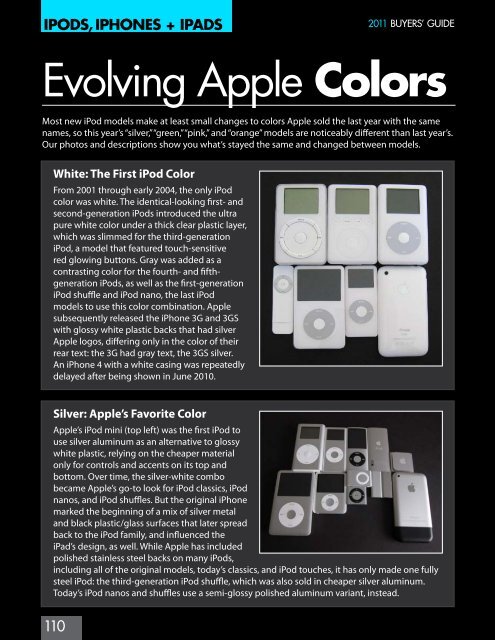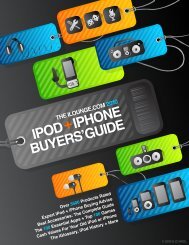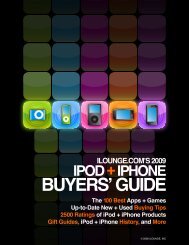2011 iLounge iPod/iPhone/iPad Buyers' Guide
2011 iLounge iPod/iPhone/iPad Buyers' Guide
2011 iLounge iPod/iPhone/iPad Buyers' Guide
You also want an ePaper? Increase the reach of your titles
YUMPU automatically turns print PDFs into web optimized ePapers that Google loves.
ipods, iphones + iPADS<br />
<strong>2011</strong> Buyers’ <strong>Guide</strong><br />
Evolving Apple Colors<br />
Most new <strong>iPod</strong> models make at least small changes to colors Apple sold the last year with the same<br />
names, so this year’s “silver,” “green,” “pink,” and “orange” models are noticeably different than last year’s.<br />
Our photos and descriptions show you what’s stayed the same and changed between models.<br />
White: The First <strong>iPod</strong> Color<br />
From 2001 through early 2004, the only <strong>iPod</strong><br />
color was white. The identical-looking first- and<br />
second-generation <strong>iPod</strong>s introduced the ultra<br />
pure white color under a thick clear plastic layer,<br />
which was slimmed for the third-generation<br />
<strong>iPod</strong>, a model that featured touch-sensitive<br />
red glowing buttons. Gray was added as a<br />
contrasting color for the fourth- and fifthgeneration<br />
<strong>iPod</strong>s, as well as the first-generation<br />
<strong>iPod</strong> shuffle and <strong>iPod</strong> nano, the last <strong>iPod</strong><br />
models to use this color combination. Apple<br />
subsequently released the <strong>iPhone</strong> 3G and 3GS<br />
with glossy white plastic backs that had silver<br />
Apple logos, differing only in the color of their<br />
rear text: the 3G had gray text, the 3GS silver.<br />
An <strong>iPhone</strong> 4 with a white casing was repeatedly<br />
delayed after being shown in June 2010.<br />
Silver: Apple’s Favorite Color<br />
Apple’s <strong>iPod</strong> mini (top left) was the first <strong>iPod</strong> to<br />
use silver aluminum as an alternative to glossy<br />
white plastic, relying on the cheaper material<br />
only for controls and accents on its top and<br />
bottom. Over time, the silver-white combo<br />
became Apple’s go-to look for <strong>iPod</strong> classics, <strong>iPod</strong><br />
nanos, and <strong>iPod</strong> shuffles. But the original <strong>iPhone</strong><br />
marked the beginning of a mix of silver metal<br />
and black plastic/glass surfaces that later spread<br />
back to the <strong>iPod</strong> family, and influenced the<br />
<strong>iPad</strong>’s design, as well. While Apple has included<br />
polished stainless steel backs on many <strong>iPod</strong>s,<br />
including all of the original models, today’s classics, and <strong>iPod</strong> touches, it has only made one fully<br />
steel <strong>iPod</strong>: the third-generation <strong>iPod</strong> shuffle, which was also sold in cheaper silver aluminum.<br />
Today’s <strong>iPod</strong> nanos and shuffles use a semi-glossy polished aluminum variant, instead.<br />
110















